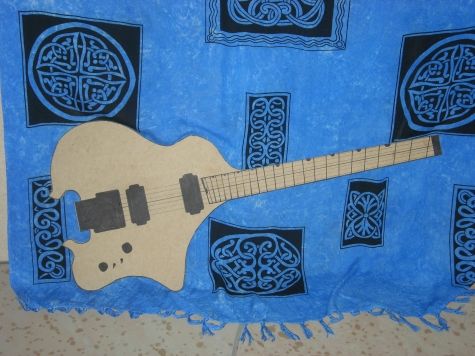Canton Custom Guitars – Three New Models
Rick Canton of Canton Custom Guitars just informed me of three new headless guitars he’s building. Rick has this to say about his goals:
My intention with these ergonomic models is to create a beautiful
guitar that is natural feeling while held, and to provide an effortless
playing experience for the musician.
I’ll let Rick describe the guitars as we look at the MDF templates for each of the design…
The first model will have a multi scale fretboard and a 3″ chambered body with an arched top. It will also have a custom milled hardtail bridge ala Steinberger.

The 2nd model will be a 30″ scale 22 fret purpleheart fretboard baritone guitar with a chambered body and a Steinberger S Trem.

The last model shown here I call the “Jazz Mini” – the width of the body is 12″, it will also have a chambered body, a curly maple/rosewood laminate neck with a figured bubinga fretboard and a custom milled tuner piece that is designed after ABM’s headless system.

Keep an eye out for updates on these three new guitars. Rick has promised to share “in progress” pictures so we can watch these guitar builds come to life…
Very interesting designs Rick!
Are these going to be neck through or bolt-ons? Will the neck be strong enough to handle a TT instead of a hardtail or ST?
Hi Trynyty,
The three models shown will all have bolt on necks except for the “Jazz Mini”, this will have a neck through design.
The chosen woods, type of construction used and graphite reinforcements installed in the necks will result in a very stable neck and most definitely would be strong enough for use with a Steinberger Trans-Trem.
Thank you for your interest and kind words,
Rick
How well will these guitars set in the Classical position with both feet on the floor? That’s really the most comfortable position for me to play in, but it can be “a pain” (not painful, just annoying) to find a foot rest for anything impromptu.
Ray
That’s generally my standard as well Ray so I’m looking forward to Rick’s reply…
Hello Ray,
The first and second models sit very well in correct classical position, ie. back straight not arched. The second model sits a tad higher bringing the neck higher, this helps in all playing positions. The Jazz Mini does well in classical position but sits low due to it`s size. All models were design primarily for the right leg position and that is their most comfortable playing position but they do all far well in classical. I will include pictures of the models in all playing positions near the final build process.
Regards,
Rick Canton
Very cool designs Rick. I am really looking forward to you building my next guitar. best, Stephen
Hey Steven,
I`m looking forward to starting…right around the corner.
Regards,
Rick
Interesting to see that the curve of the upper bout is different on each. My favorite is the second one. For looks only that is. The only thing I would change is that the upper “line” that ends from the upper horn – joins neck at 16th fret it seems – should pass “invisible” through the neck and come out again on the other side of the neck – at say, 17th or 18th fret, to form a homogenous line. But that’s just for aesthetics, it would be slightly harder to play up there.
I notice even here, it’s still something “fishy” and “sharky” about these body shapes. There’s something “living in the water” shape about all these ergonomic guitars bodies. But hey, Rick, I wish you really good luck on these, it seems like a major feat!
I see the fish shape in ergo guitars as well. There’s something very organic about them.
Thanks for the kind words Mats.
I understand the “living in the water” view, I have about 7 templates leaning against a wall and occasionally they all seem to appear strangely alive at times 😉
The necks should be taking shape soon and I`ll pass on pictures to Robert when the time is right..
Regards,
Rick
The designs of the first two guitars shown remind me of manta rays…..
What are the scale lengths of the Multi-Scale? If they’re not in the range of 28″ – 25″, would you consider doing a “Baritone Scale” version down the road?
Ray
Greetings Ray,
The first model shown (top model) will have the treble E of 24-3/4 and the bass E at 25.5″. The baritone will be the 2nd model, that will be one scale length of 32″, I was thinking of 30″ before but now it will be 32″ with 24 frets. I have 2 other Multi-Scale purpleheart fretboards that I cut ranging in the 26″ to 28″ area treble to bass. I really enjoy the Multi-Scale`s ergonomics, they are very easy to play and take under a minute to get used to. I also love the tone of baritone guitars, for me, anything past 30″ hits the mark for true “baritone land”.
For the Multi-Scale lengths past 25.5″, the instrument needs the ABM single tuners if it would be headless.
Regards,
Rick